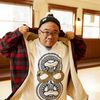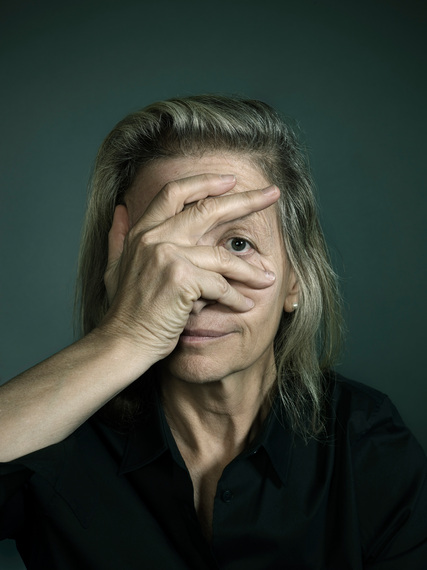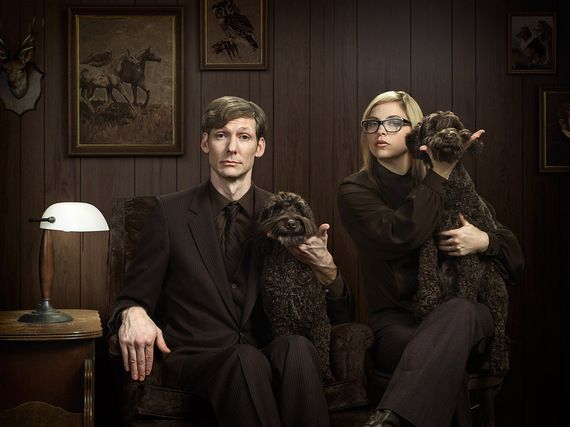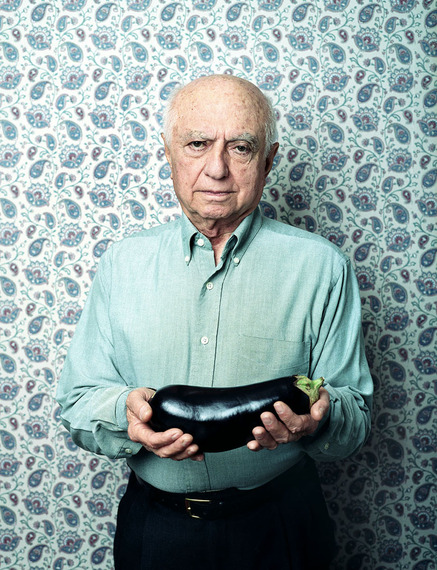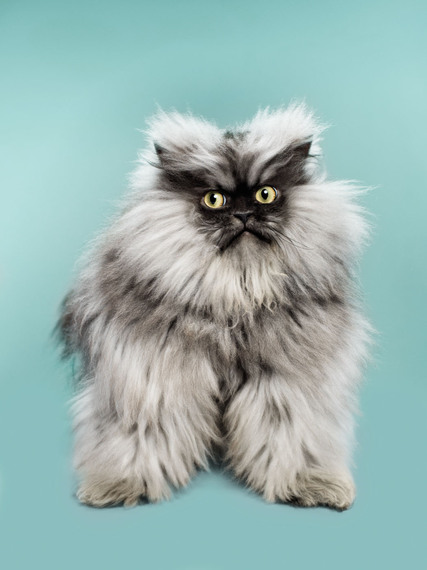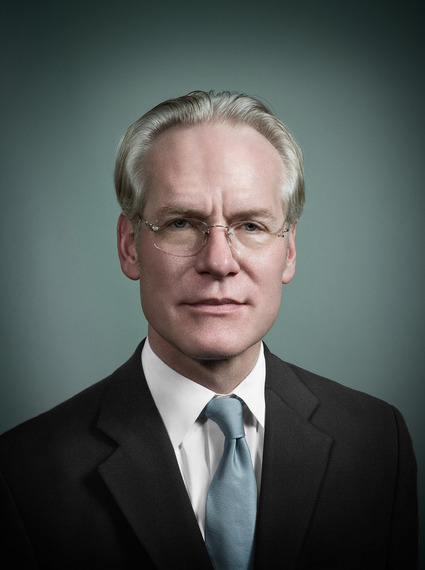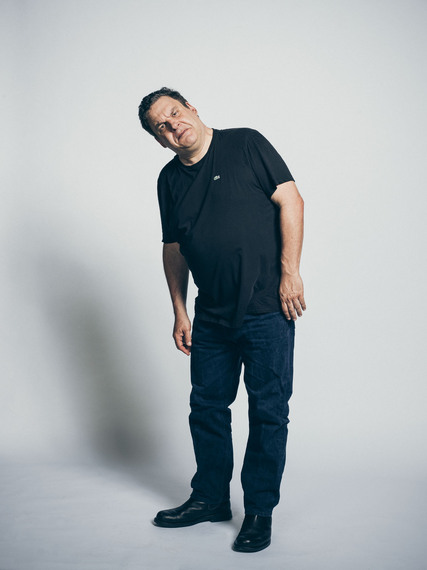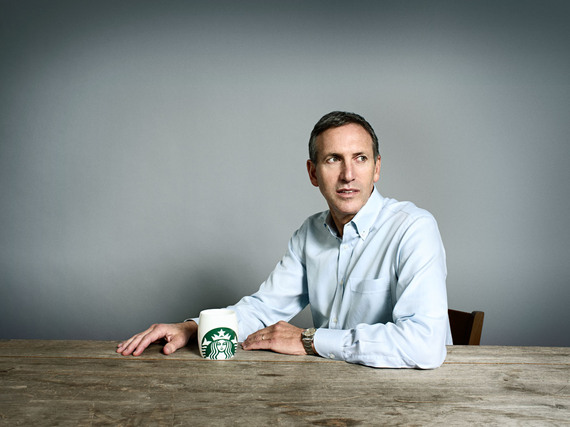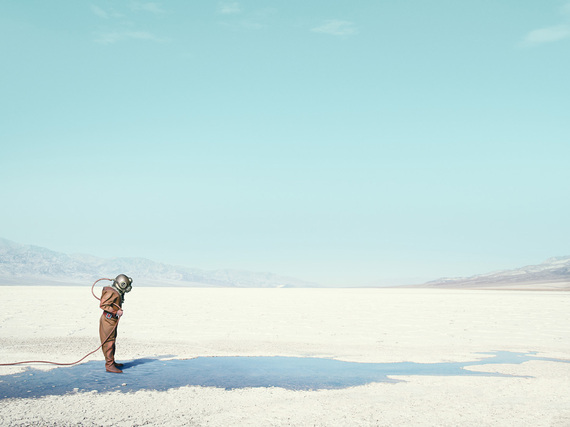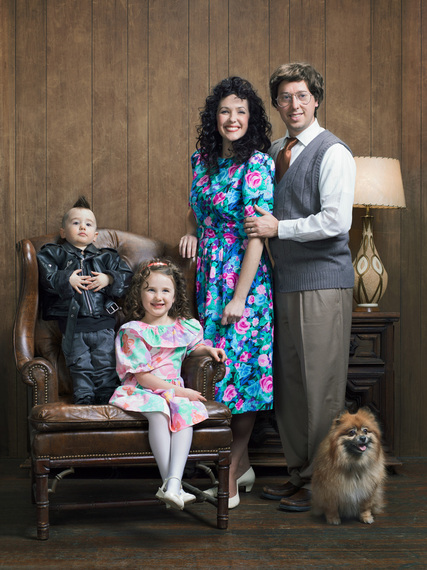According to his biography, he's "swapped photography stories with Annie Liebovitz, taken geography lessons from Sarah Palin, and learned to craft the perfect cocktail with the best bartender in the country." He's an amazing photographer who is able to get the best out of his friends grandfather and get the best out of Macklemore. His sense of humor is evident in his work, but you really have to sit down with him to feel his greatness.
I'm not going to lie, I was a bit nervous to sit down with him. To me, his work is held in high regard and so imagine the opportunity to talk shop with him. In order to do so, I came to his studio bearing gifts; a couple sports cards of Seattle players who represent the best in their work. It was my way of telling him that he is the Marshawn Lynch, the Gary Payton, the Feliz Hernandez of portrait and conceptual photography in Seattle. Of course this is my opinion but I'm sure you could ask around and not only will local photographers agree, but shooters from around the world would say the same thing - at least how it translates to their favorite sports heroes and legends.
With that said, I want to introduce you all to John Keatley!
What's up, John! Thanks for the opportunity to interview and talk story with you. To start off, would you please introduce yourself: who is John Keatley?
As a quick overview of who I am, I'm John Keatley. I'm married to Nichelle and we've been married for over nine years. I have two kids, Isla (5) and Jett (2 ½). I love my family and of course they are very important to me.
My wife and I both have come to love food in the last couple of years. One of my favorite things is to eat in a new restaurant and try new food.
I also love running which I started doing a few years ago. I still have a lot of work to do but running has become a huge part of my life.
I'm a curious individual. I find myself always interested in something new. It seems there's always something new I'm pursuing on the side. I love creating obviously photography and directing but anything I can create will make me happy. I love building things and using my hands. Art is a big part of my life and it's not just a job. It's something that I think about constantly.
Oh and I love sports. I'm obsessed with sports. Primarily Seattle sports. I grew up in California and so I grew up a Dodgers fan but since moving up here, it's been about the sports in Seattle. The Dodgers still hold a special place in my heart. Because of my love for the Dodgers and my love for Seattle sports, I sports hate the LA Angels but even more so the San Francisco Giants and 49ers.
I moved up to Seattle in 1999. So Seattle is home. I'm a very loyal person and I feel like I would fight anyone who would say anything bad about Seattle teams. (laughter) SO now it's all Seahawks and Mariners for me. I didn't really get into the Sonics. I moved here a little late for that and then they got moved.
As far as the Seahawks go, one of the hardest decisions of my life - I'm kind of half joking here - I had last year was which Seahawk jersey to buy last year. It was between Marshawn Lynch and Russell Wilson and ultimately I decided to go with Wilson.
Please tell us about the beginnings of you as an artist and a creative.
I grew up being encouraged to be creative. I remember building a lot with my dad or on my own, whether it was building tree forts or a soapbox racing car or a skate ramp. I was always making things. I was always creating things hands on even though it wasn't necessarily art. My parents always encouraged me. I think anything that I expressed interest in, they would tell me I was good at it - as any parent would. In looking back, I know now that I wasn't a very good painter or not good at drawing but they always gave me that encouragement. In a lot of ways they empowered me to just create.
Nothing ever really stuck or I wasn't really great at anything. I played music while growing up. I played bass through college but I was never really great at it. I always had this driving need or desire to be great at something. I wanted something that I can hone or better yet craft to get better at and reach that great status.
It wasn't until I started taking pictures where I saw that opportunity. I was taking pictures just for fun and I never really considered it like a career type thing. Then I turned in some film and Colleen, this woman at the drugstore film lab, pulled me aside and just said, "You have a good eye. Have you ever considered thinking about becoming a photographer?" This came at a period in my life where I was questioning what I was going to do with my life. I was still in college and I didn't have any answers nor was there anyone who could've given me any answers about what I was going to do. Then comes this woman talking about something that I just started enjoying and tells me that I might enjoy making a living out of it. I blindly grabbed onto that, latched all of my emotion, thought, and time onto.
So looking back, I see a lot of reasons why it worked. Going back to that time, it was really just on excitement. It wasn't at all calculated. I just told myself that I was going to do this because I want to do it. Now I see why and how photography makes so much sense for me.
Photography and now directing, and working with people; gives me something tangible to work and mold with. I'm not the type of person who can sit down with a blank piece of paper and draw or paint something. I might have an idea in my head but translating it out, doesn't always look how I want it to look like. So working with people, working with physical objects; just works with my personality and how my mind works. There's something about creating and molding a situation whether truthful or literal or not, it's something that I truly enjoy. I love creating stories. I love taking pictures and giving direction. I'm much more of a directing photographer and all the little pieces looking back makes a lot of sense.
So I started doing wedding photography. It was a great way to take pictures and make money. I was just excited about photography and I needed to get money. Again it started out as a drive to progress in what I wanted to do. I started assisting a wedding photographer which then progressed to wanting to shoot my own weddings. I did whatever it took to make that happen. Once I achieved my goals in that part of photography in about 5-6 years, I started to become very restless and frustrated and angry. I started dreading going to work. I realized at that point I wasn't just happy holding a camera in my hand. There was something more specific that I wanted to do. I don't think that I knew immediately what that was but pretty quickly I started moving towards doing conceptual and/or editorial photography. I wanted to create images that were a true reflection of who I am and what I wanted to say. I didn't want to just document or capture something that was happening in front of me.
I wanted to create something. I wanted to say something.
It was to the point I wasn't doing good at my weddings and I wasn't doing good at my portrait work. I knew that if I wanted to be great at something - which I did - I needed to do one thing. At that time, I was just "ok" at a bunch of things. So when I reached that realization I decided to cut off weddings. Which at the time, was really scary because that was about 90% of my income. There were some dark times definitely but I look back at the journey and I'm incredibly thankful. I feel like I grew and I learned so much from it.
My first portrait was of a man named Albert. He was the grandfather of a friend of mine, Darrius. Darrius had made short films of his grandfather. Rightfully so because Albert was this really interesting guy. He was Armenian but had been living in the states for quite some time. He just had this unusual way of living life. He had certain habits and a different way of looking at things that made him interesting. Darrius had these great videos of him - which were hilarious - and so I wanted to photograph Albert.
I had been taking pictures, I had a pretty good camera, and I had some lights - I can't say that I knew how to use them really well - but I had got to the point where I was familiar enough with the tools to do the work. At this point, I had an idea of what I wanted to do but I wasn't doing it or necessarily knew how to do it.
So I did this shoot with Albert. I had some ideas going into it but there were surprises that came up along the way. Looking back, I see I didn't plan it the best I could. From the shoot, I came up with 3 pictures and it wasn't until I got the film back where I was, "Holy cow! This is really cool."
Then I thought, "This could be in a magazine," which is so funny because it doesn't really mean anything because anything can be put in a magazine. The cool thing is that with my mindset back then and that realization, I came up with pictures that started me moving on what I wanted to do. This was what I aspired to do with my work. It was in that style that I was wanting. I surprised myself because I didn't know where it came from.
At that moment I knew what I was capable of doing and what I wanted to do. Even though I still had a ways to go, I knew where I wanted to go.
That was a big moment for me. It was a big discovery.
Tell us a bit about how you added "you" and your vision into your work!
I have a list of words that describe who I am.
I also have a list that describes the brand, Keatley, but really the brand is me. The words that I think describe me: bold, timeless, confident, smart, dry humor, honest/ genuine, simplicity, and a sense of greatness. I'm not saying I'm great but I have this drive or desire to be great. I have to acknowledge that it's there.
All those things I have seen time and time again in my life. Some of them are actually bad characteristics. Some of them are actually my worst qualities as a father or as a husband but I think they are my greatest qualities as an artist. So it's hard sometimes to separate who I am and what makes me an artist. Being great or my career drive can get in the way of who I am at home.
Being aware of who you are, being aware of what drives you, and being true to that is the only way to create something original and something consistent. Also just in the simplistic level, staying true to who you are. For example, my favorite color is blue. If you look at my work, there's a lot of blue. It's not necessarily a conscious decision. It's making those choices and decisions that I want to make.
Another big part of my work is emotion. I am a very emotional person and I am very aware of people and their emotions. I am also very aware of my surroundings. It all affects me and so this drives my work as far as how it feels.
Going back to directing and telling a story, I'll dress my subjects in a way that I would dress myself. I'll pick the clothes that I like. It doesn't mean that it's their favorite clothes or it's how they normally dress, it's what I see when I direct them. I'm not trying to paint a picture about the person I'm photographing. My work is more a reflection of who I am than the subject.
So if you see consistency in my work, it's because I'm making decisions on my work that I can only make.
You can learn everything I do, the way I light, learn what I learned but you'll never be able to replicate my decision making process. So if someone stays true to themselves and stays true to what they are most interested in, then that's what's going to make their work and make it stand apart from anyone else.
Of course I've got to touch upon your celebrity work. Can you share a story with a couple of celebrities you've worked with that stand out as your most memorable?
I've been very fortunate that most of the people that I've worked with have been awesome. There definitely has been situations over the years where there's been someone who's been harder to work with than another person. You never really know what the backstory is. How their day is going? What did they find out before coming and doing a shoot with me? So I don't take it personal. When I first started out, I used to dream about photographing celebrities because I thought once I did that or grew to a certain level in my career, that its going to be easier. People are just going to trust me and I won't have to fight so hard to try and take a picture that I want to take. Well that was a pretty ignorant thought on my part. The bigger the stakes, the harder it is. It didn't and doesn't get any easier.
There were times when I first started out where it was hard. They probably looked at me and thought, "who is this guy?" "Let me just get in here and get my headshot and be done." It took a while to get past that stage in my work. They didn't take the time to understand what I wanted to do. Tim Gunn was one of the nicest people, especially considering when I shot him I really was just starting out and I had a lot to learn. I don't even remember the kind of mistakes I made on set but he was so kind and gracious and even asked me if I wanted more time. That almost never happens because usually they just want to finish and get out. So he's definitely one of the ones I will remember the most.
Recently, Jeff Garlin was one of my favorite people to work with. He was so fun. I really had a great time with him. He wasn't just nice on set, he went out of his way to spend time with me and the crew and I really appreciated that. He's someone I always respected, so that meant a lot coming from him.
You've also begun a new track in your career by providing creatives a chance to learn from you and at the same time learn to create using their own voice and vision. Can you tell us a bit about your teaching and workshop programming?
Along my journey into photography, there's been several people who had a huge hand in helping me and allowing me to be successful in doing this as a living. From Colleen - the first person to pull me aside at the drugstore lab and told me I had a good eye - to Jimmy Lott from the Seattle Times - who spent time mentoring me, giving me great advice and harsh criticism. They were some of those people who helped me shape my career. The list goes on and on. It's that realization of knowing that there were those who wanted to help me. I think because of this it's so important to return the favor.
It's so easy for me to run around and do the work that I do day to day. It feels really normal and comfortable now. It's hard to remember sometimes the questions that I used to have when I wanted to do this before. Even people who are going to art school, they don't really teach you how to run a business. They teach you the intricacies of how to create, working in a studio, or working lights, and that's great but honestly that's really just 10% of it. Actually getting a job, working with a client, producing and delivering, invoicing, doing your taxes, and all of that stuff; if you can't do these things, you're not going to be making art for anybody.
We get a fair amount of questions on email or phone calls about things. It's unfortunate that we don't have the time to answer them individually. So we decided a couple years ago to do a workshop about these things. It's been a process much like my photography. I needed to see what I wanted to do with workshops and teaching. I could do workshops on lighting and that would pay really well but what I learned is that I really don't like teaching lighting. I mean I can do it and it doesn't mean I won't do it but it's not something that I'll just go out and do. In college I majored in business. Man, I love business and I'm incredibly passionate about creating something out of nothing. Not just in art, but even in business. Taking an idea and turning it into a business, and supplying the people what may be in demand. And if it changes, how do you shift to meet that demand.
Teaching business and marketing strategy; these things is what I love and its what we do on a daily basis here at Keatley. So I find joy in providing these workshops to people and then seeing it in their eyes that they've been able to move forward and covering their own goals. This really is the best and most exciting part. It's is meeting someone who is more than capable but just doesn't know how to do it, providing them with the tools and what we learned, and watching them go out and do it.
We have a workshop now called, "Survival Guide" and the tagline is, "Teaching Artists to Survive in Unfamiliar Territory." Really that unfamiliar territory is the business world.
The Woodsman
You've started moving towards directing and moving pictures. Tell us more about that and how that's going?
Before I even picked up a camera, I made videos when I was a kid. When I was in junior high, I saved up enough money to buy a Sony Camcorder and made skateboard and other types of videos all the time. I remember this one time I made a stop motion video of Legos and action figures and I stayed up for like 18-24 hours straight. I was so enthralled with this process and I didn't even think about trying to get any sleep.
So video isn't something new to me but when I got into photography, I totally focused on photography 100%. Over the last several years, there's been this thought or idea in the industry that you have to be able to make videos as well as take pictures. I really fought that because I'm a bit of a contrarian and I didn't want to do something just because someone was telling me I had to do it. But I still have this complete fascination with creating and I didn't want to be limited as someone who just takes pictures.
I made this self-promotional video to bring people towards my photography called, "The Woodsman." That was something that helped me start thinking more and more about video. I started looking at my journal of ideas and began thinking, "Is this a picture or is it something else?" I was finding a lot of my ideas that I was really trying to force into pictures. So I started to step back and look at some of those ideas and thought that some of them would be good as a short film. Now I try to look at ideas and try to figure out first, "What is this?" and go from there, rather than trying to force it into a still image.
There came a point last year, through many conversations with people, that motion is really starting to become important in this industry. I already had the desire so it became an excuse and/or a justification to put a little more time into those personal projects that could be told through videos. I did one of those called "Glory Days" and before we could even finish it, I started getting calls for directing commercials and things like that.
I certainly had some learning to do in terms of working with a motion crew as opposed to working with a still crew but a lot of it was very familiar. Again going back to photography, I've always taken the heavy handed approach in directing people. The idea of emotion and awareness feels really natural and translated from still to motion with no issues.
Now I'd say we are doing 50% stills and 50% motion and it feels very seamless to me.
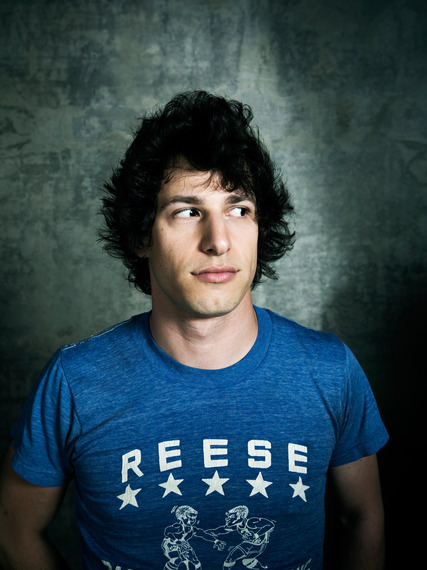
Andy Samberg by John Keatley
Can you tell us about your thoughts on Instagram and the idea of mobile photography? For example your iPhone portrait series is awesome, can you fill us in on this project of yours?
I'm not an early adopter of Instagram or mobile photography. My first iPhone was the iPhone 5. I didn't sign onto Instagram until after that. I had Facebook and Twitter and at the time. I almost kind of resented social media. It just felt like so much work and I didn't really want to add another social media platform to my list of things to do.
I remember people were telling me, "You got to get on to Instagram" and they were saying there was value to it. So then I decided to sign up after all. Before I signed up though, I knew I wanted to have a purpose for it. I just didn't want to post random pictures of what I'm doing or what I'm having for lunch that day. So I knew I wanted to do something but didn't know what exactly.
The iPhone portrait series was really by accident. One day I saw this light in this building that I was in. It was from this beautiful skylight and I wanted to take a picture of someone and I didn't have my camera with me. I've always been kind of a camera snob and I used to think, "what's the purpose of creating something if it wasn't done with a medium format" (laughing). So I was like, ah, all I have is this stupid iPhone so I guess I'll just take a picture. I mean the light was so beautiful and at the least it was worth the memory even if its from a pixelated camera phone or something. So I took the picture.
Then I was kind of surprised later on how it turned out. I had these mental blocks in my head and really wasn't able to see the portrait for what it was. After a couple people starting commenting on it, I then realized that it was kind of cool. The light bulb went up. One day I realized a lot of what I do is produced and it takes days or weeks to put it together to create one image and that's not exactly conducive to posting on a daily basis. But I love people. I love portraits. Then I started realizing that I meet a lot of cool people and they aren't necessarily the subject of my photos. So I thought, what if I just started taking portraits of people that I encounter on a daily basis and not produce it, just use natural light - imagine that. This wasn't going to be work or a production or just going through the motions. This would allow me to not be so picky and not get hung up on stray hairs or a stain on a shirt. It was spontaneous and the stories that I got from people were amazing.
It's definitely become a really close and personal project for me.
It's become a project that taught me to fall in love with photography again.
Besides the iPhone Portrait series, are there any other personal projects that you worked on that you can share with us?
I'm not much of a project photographer. I know a lot of people have projects they do. I've always wanted projects and I've always struggled because I can never come up with something. I think a big part of that for me is that I lose interest so quickly. Once I feel like I've done something then I'm kind of done with it. There's very few things where I won't lose interest and portraits is one of them.
I've done some short term photo projects for non-profits and some humanitarian work. Certainly these have made a big impact on my life. One of these is a project I did in Liberia for Miir. Another one I did was with First Aid Arts in the Philippines, where they provide art therapy and tool kits for victims of trauma and sexual slavery. These projects were definitely very personal and dear to my heart.
Beyond that though, the one thing that I have been working on, on the side and on a completely different level, is conceptual landscapes. It's not really a cohesive series as each piece, each story is a little different. It's the idea of exploring space and characters and story through single images which is what I've been exploring. So this is the other project along with the iPhone Portrait series that will continue for awhile.
The future looks awesome for you man. What's next down the road for you?
I am currently working on a couple of personal shows. One of which is personal work, the conceptual landscape we talked about earlier. I'm still trying to decide on which direction to go on. I'm also working on a collaborative project with a painter and we're working on doing a show together with a theme and a story that we've been working on within the last year.
I will be always working on the iPhone Portrait series. Also teaching has been huge. We've been focusing a lot of time the last few months on that curriculum and possibly doing an online tutorial.
There's like 3 different things going on at the same time and thankfully I have a great team and really great people that I work with.
But I know this much. Creating will always come first. I don't ever want to get into something and put any of my time into something that isn't anything but creating. My goal is to always take the work that we create and are excited about. I have to make sure the work is created for ourselves and not just our clients.
Last question; as an amazing and popular and as sought out as you are, where do you find time for your family?
You know, it's different and it depends on what time of the year, but right now we're in a stretch where I have a lot of time for them actually. At 5pm, I pretty much call it a day and go hang out with the family. Especially during this time of the year in the summer, we get a lot of light so that means a lot of time with them. I try to be very protective of the weekends which is something that my wife and I have learned over time is important for us to do. It's taken 15 years to figure it out and it'll take more time to get better at it but we're getting good at making sure we keep time for ourselves. It's not easy working for yourself sometimes and although you have freedoms you still have to learn how to take advantage of them.
I think if you asked me that question during other points in my career, I probably wouldn't have had an answer for you and it may have looked pretty bad for my family. Right now though, we are in a pretty good place. We are able to find a good balance.
It's not to say that it's easy. I've always been very driven and I've always had something I was working towards. I've always got to do this or I have to be great at this. I've been doing photography and creating for 15 years now and so I'm starting to see the cycles. Oh I can take vacation during this time or I don't need to always take on a celebrity shoot. So I've started to calm down a little bit about it. I've also come to realize what's really important. For example, if I've been shooting advertising for the last 10 years then I start to get good at it. Then I realize, "sure this is awesome and its fun, but it's not everything."
I am incredibly grateful for this. I don't want to come off as boastful or take things for granted but when you start to achieve your goals at a certain level it does start to put things into perspective. It's cool and you're really good at it, but you also know that it's not the only thing that makes you happy. It doesn't mean you can't have those goals and you can't work towards it but you start to really realize what's important.
I have kids and they are who I see every morning and I know that they aren't going to stay kids for very long. This is definitely something that I won't lose time on and will fight for.
I don't want to be thinking about it when it's too late.
Being a parent is crazy and awesome at the same time. Then crazy again. Then beautiful.
Follow John Keatley's work: Keatley Photo : Instagram : Twitter : Facebook
